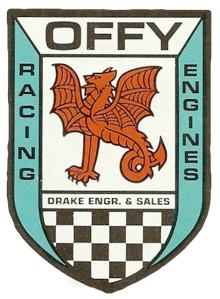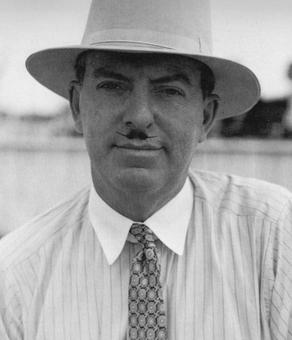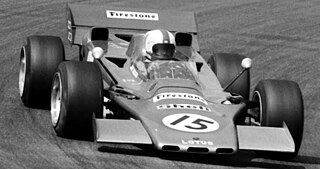
Championship Auto Racing Teams (CART) was a sanctioning body for American open-wheel car racing that operated from 1979 until dissolving after the 2003 season. CART was founded in 1979 by United States Auto Club (USAC) Championship Division team owners who disagreed with the direction and leadership of USAC, with the then-novel idea of team owners sanctioning and promoting their own series collectively instead of relying on a neutral body to do so. Through the 1980s, CART's Indy Car World Series became the pre-eminent open-wheel auto racing series in North America, featuring street circuits, road courses, and oval track racing. CART teams continued to compete at the USAC-sanctioned Indianapolis 500, which was effectively integrated into the series schedule.

Daniel Sexton Gurney was an American racing driver, engineer and motorsport executive, who competed in Formula One from 1959 to 1970. Widely regarded as one of the most influential figures in the history of motorsport, Gurney won four Formula One Grands Prix across 11 seasons. In endurance racing, Gurney won the 24 Hours of Le Mans in 1967 with Ford, as well as the 12 Hours of Sebring in 1959 with Ferrari.

The United States Auto Club (USAC) is one of the sanctioning bodies of auto racing in the United States. From 1956 to 1979, USAC sanctioned the United States National Championship, and from 1956 to 1997 the organization sanctioned the Indianapolis 500. USAC serves as the sanctioning body for a number of racing series, including the Silver Crown Series, National Sprint Cars, National Midgets, Speed2 Midget Series, .25 Midget Series, Stadium Super Trucks, and Pirelli World Challenge. Seven-time USAC champion Levi Jones is USAC's Competition Director.

The Offenhauser Racing Engine, or Offy, is a racing engine design that dominated American open wheel racing for more than 50 years and is still popular among vintage sprint and midget car racers.

All American Racers is an American-licensed auto racing team and constructor based in Santa Ana, California. Founded by Dan Gurney and Carroll Shelby in 1964, All American Racers initially participated in American sports car and Champ Car races as well as international Formula One events with cars named Eagle. The Formula One team, based in the United Kingdom and using British-built Weslake engines was named Anglo American Racers. Under team manager Bill Dunne they set up shop in Rye, East Sussex. The team were adjacent to Harry Weslake's engine development plant and half a mile from Elva cars. They participated in 25 Grands Prix, entering a total of 34 cars.

American open-wheel car racing, generally known as Indy car racing, or more formally Indianapolis car racing, is a category of professional automobile racing in the United States. As of 2024, the top-level American open-wheel racing championship is sanctioned by IndyCar. Competitive events for professional-level, open-wheel race cars have been conducted under the auspices of various sanctioning bodies, tracing its roots as far back as 1902. A season-long, points-based, National Championship of drivers has been officially recognized in 1905, 1916, and each year since 1920. As such, for many years, the category of racing was known as Championship car racing. That name has fallen from use, and the term Indy car racing has become the preferred moniker.

Harold Arminius Miller, commonly called Harry, was an American race car designer and builder who was most active in the 1920s and 1930s. Griffith Borgeson called him "the greatest creative figure in the history of the American racing car". Cars built by Miller won the Indianapolis 500 nine times, and other cars using his engines won three more. Millers accounted for 83% of the Indy 500 fields between 1923 and 1928.

The Lotus 56 was a gas turbine-powered four-wheel-driven racing car, designed by Maurice Philippe as Team Lotus's STP-backed entry in the 1968 Indianapolis 500. All three cars entered and retired from the race with Joe Leonard's car expiring while leading just eight laps from the finish.
Gerald Wayne "Jerry" Grant was a driver in the USAC Championship Car series. Born in Seattle, he began racing sports cars in Northern California in the early 1960s. He raced in the 1965-1977 seasons, with 54 career starts, including the Indianapolis 500 in 1965-1968, 1970 and 1972-1976. He finished in the top ten 13 times, with his best finish in 3rd position in 1974 at Ontario.
Joseph Paul Leonard was an American professional motorcycle racer and racecar driver.
James H. Malloy Jr. was an American racecar driver.

The Eagle Mk1, commonly referred to as the Eagle T1G, was a Formula One racing car, designed by Len Terry for Dan Gurney's Anglo American Racers team. The Eagle, introduced for the start of the 1966 Formula One season, is often regarded as being one of the most beautiful Grand Prix cars ever raced at the top levels of international motorsport. Initially appearing with a 2.7L Coventry Climax inline 4-cylinder engine, the car was designed around a 3.0L Gurney-Weslake V12 which was introduced after its first four races. In the hands of team boss Gurney, the Eagle-Weslake won the 1967 Belgian Grand Prix, making Dan Gurney only the second driver at the time, and one of only three to date, to win a Formula One Grand Prix in a car of their own construction. Excluding the Indianapolis 500, that win in Belgium still stands as the only win for a USA-built car as well as one of only two wins of an American-licensed constructor in Formula One. It was also the first win for an American constructor in a Grand Prix race since the Jimmy Murphy's triumph with Duesenberg at the 1921 French Grand Prix.

Indianapolis 500 Evolution is a racing game, developed by British studio Brain in a Jar Ltd, based on the Indianapolis 500 and American Championship car racing from 1961 to 1971. It is similar to Destineer's 2007 game Indianapolis 500 Legends. In the game, players take on the roles of various famous racers from that time period with 21 missions, photos, and movies, as well as competing on courses such as the Indianapolis Motor Speedway, as well as the Milwaukee Mile, Trenton, Riverside, Hanford and Langhorne Speedway. Honey Creek, the name for inner road course of the Milwaukee Mile, is also included, and is still used for various club racing events in the present day.

The Cooper T54 is a rear-engined open-wheel race car chassis, designed, developed, and built by Cooper, for U.S.A.C. Indy car racing, between 1961 and 1963. It was powered by a 250 hp (190 kW) 2.75 L (168 cu in) Coventry Climax FPF four-cylinder, but later used an Aston Martin six-cylinder engine, installed by automotive mechanic and engineer Joe Huffaker, after the car had been by Jim Kimberly to Kjell Qvale. After competing in IndyCar racing, it competed in a variety of different motorsports, including sprint car racing, where it was powered by larger Ford, Buick, and Chevrolet V8 engines.

The Ford-Cosworth Indy V8 engine is a series of mechanically similar, turbocharged, 2.65-liter V-8 engines, designed and developed by Ford in partnership with Cosworth for use in American open-wheel racing. It was produced for over 30 years and was used in the United States Auto Club (USAC) Championship Car series, CART, and Champ Car World Series between 1976 and 2007. The DFX engine was the Indy car version of the highly successful 3-liter Ford-Cosworth DFV Formula One engine developed by former Lotus engineer Keith Duckworth and Colin Chapman backing from Ford for the Lotus 49 to campaign the 1967 season. This engine had 155 wins between 1967 and 1985 in F1. The DFX variant was initially developed for Indy car use by Parnelli Jones in 1976, with Cosworth soon taking over. This engine won the Indianapolis 500 ten consecutive years from 1978 to 1987, as well as winning all USAC and CART championships between 1977 and 1987. It powered 81 consecutive Indy car victories from 1981 to 1986, with 153 Indy car victories total.
The Ford Indy V8 engine is a V-8 engine, initially specially designed by Ford for Indy car racing, from 1963 onwards, winning the Indy 500 four times as Ford, plus once as Foyt in 1977.
The Lola T150, and it's the derivatives, the T152 and T153, were open-wheel racing car chassis, designed and built by Lola Cars to compete in USAC IndyCar racing series, between 1968 and 1970. The T150 and T153 were powered by the 159 cu in (2.61 L) 780–900 hp (580–670 kW) Ford Indy V-8 turbo engine; while the T152 chassis used a 159 cu in (2.61 L) 900 hp (670 kW) Offenhauser 4-cylinder turbo engine. Both the T150 and T152 used a unique four-wheel-drive system, which would be banned after the 1969 season. The T153 only used a conventional two-wheel-drive (rear-wheel-drive setup. The different chassis would, over the span of three years, win a total of 9 races, all while being driven by Al Unser.

The Kurtis Kraft 500B, 500C, 500F, and 500G, are a series of open-wheel race cars, designed, developed and built by Kurtis Kraft, for AAA and U.S.A.C. Indy car racing, between 1948 and 1960.

The Eagle 69, also known as the Eagle Mark 7, was an open-wheel race car developed and built by Dan Gurney's All American Racers team, designed to compete in USAC IndyCar racing, starting in the 1969 season. In its most powerful form, It was powered by a small-displacement turbocharged Ford V8 engine, capable of producing over 800 hp (600 kW).
The Eagle 70 was an open-wheel race car developed and built by Dan Gurney's All American Racers team, designed to compete in USAC IndyCar racing, starting in the 1970 season.













